AI-Driven A/B Testing for Social Headlines

You can change how your social headlines work with AI-Driven A/B Testing. This tool lets you pick headlines automatically. It helps you learn from what people do right away. It can help you get more likes and clicks. Big companies have seen great results. For example, The New York Times got up to 50% more clicks on some headlines. The table below shows how much better some groups did with AI headline testing:
Organization | Metric | Improvement (%) |
|---|---|---|
The New York Times | Peak CTR increase on select headlines | Up to 50% |
The New York Times | Average CTR increase across sections | 20-30% |
The New York Times | Increase in comments and sharing | 25% |
RebelMouse | Increase in CTRs after AI optimization | 25% |
Typli | Increase in engagement (likes, shares, comments) | 30% |
BBC News | CTR and engagement boosts | 15-40% |
If you want results like these, think about using AI in your social media plan.
Key Takeaways
AI-driven A/B testing lets you quickly find the best social headlines. It does this by testing many choices on its own. This method learns from how people react right away. It keeps making clicks, shares, and engagement better. Making headlines fit different groups helps your posts work better. It also makes them more interesting. You need clear goals and good data to get results you can trust. This will help you do better on social media. AI tools save time and cut down on guessing. They help you keep making your headlines better for great results.
AI-Driven A/B Testing Benefits
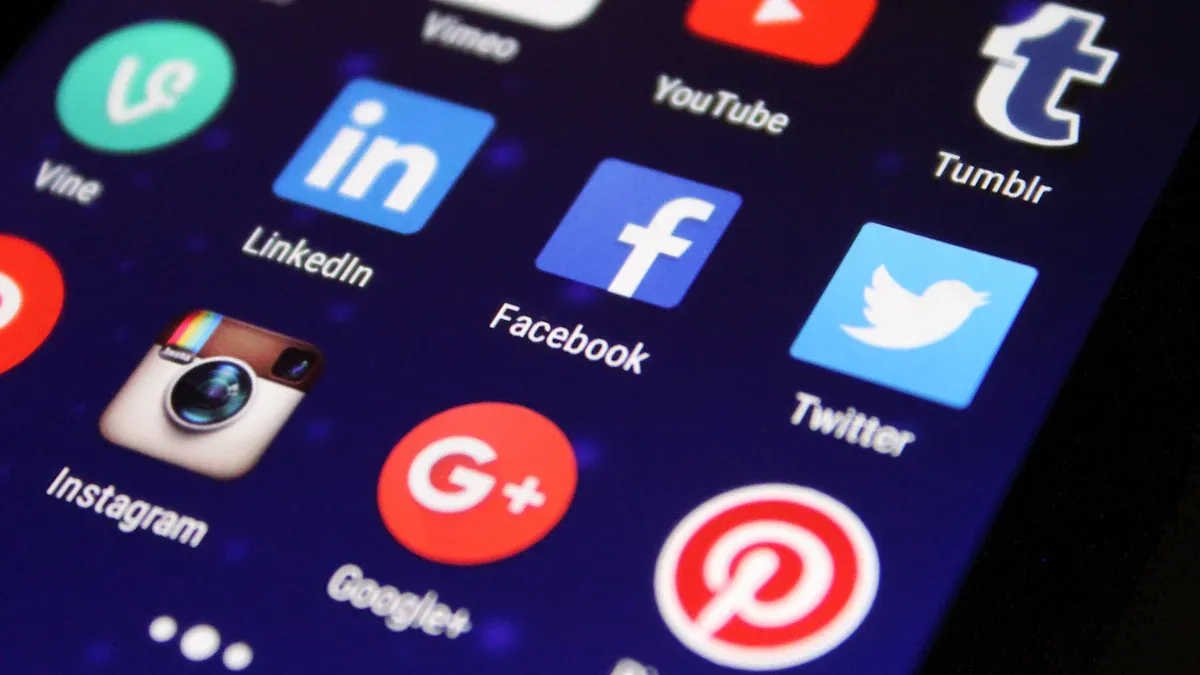
Speed and Automation
You want your headlines to perform well right away. AI-Driven A/B Testing gives you that speed. The system can test many headlines at once. You do not have to set up each test by hand. The AI picks the best headlines and shows them to your audience. This process saves you time and effort. You can focus on your content while the AI handles the testing.
Tip: Let AI handle the heavy lifting. You can spend more time creating and less time managing tests.
Real-Time Learning
AI-Driven A/B Testing does not just run tests. It learns from every click, share, and comment. The system adapts as your audience reacts. You see results in real time. The AI updates which headlines get shown based on what works best. This feedback loop helps you get better results with each post.
Here is a table showing how real-time AI adjustments have improved results for top companies:
Company | Measurable Result |
|---|---|
HubSpot | 40% increase in click-through rates via AI-driven dynamic ad targeting and content adjustments |
Amazon | 25% reduction in cart abandonment through AI real-time retargeting ads |
You can also see the impact in key metrics:
Metric | Result |
|---|---|
Click-through rate increase | 38% (The New York Times) |
Average engagement time | +25% |
Subscription sign-ups | +15% |
Likelihood to convert | +20% (users interacting with AI headlines) |
Social media shares | +12% |
Bounce rate | -10% |
Pages per session | +5% |
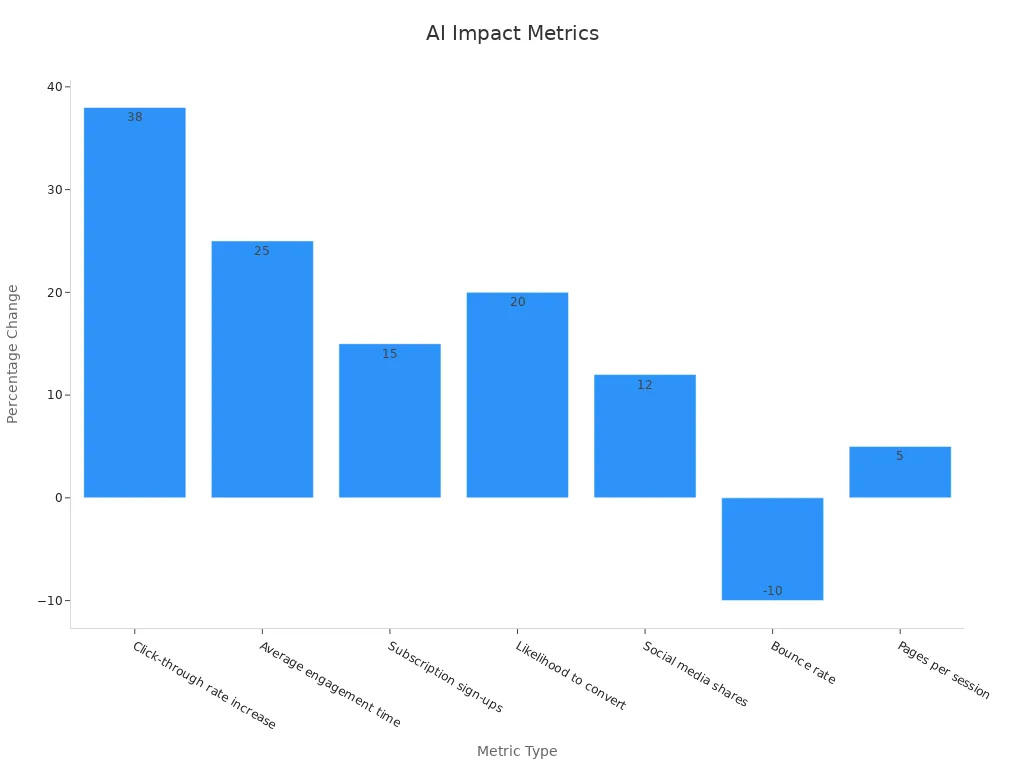
These numbers show that real-time learning leads to more clicks, longer engagement, and higher conversions.
Personalization
Every audience is different. AI-Driven A/B Testing helps you reach each group in the best way. The AI looks at user data and finds patterns. It can show different headlines to different people. This means your message fits each reader better. You get more engagement because your headlines feel more personal.
You can target users based on their interests.
The AI can adjust headlines for time of day or device type.
Your posts become more relevant to each person.
Personalization makes your social media stand out. You connect with your audience in a way that feels natural and direct.
Process Overview
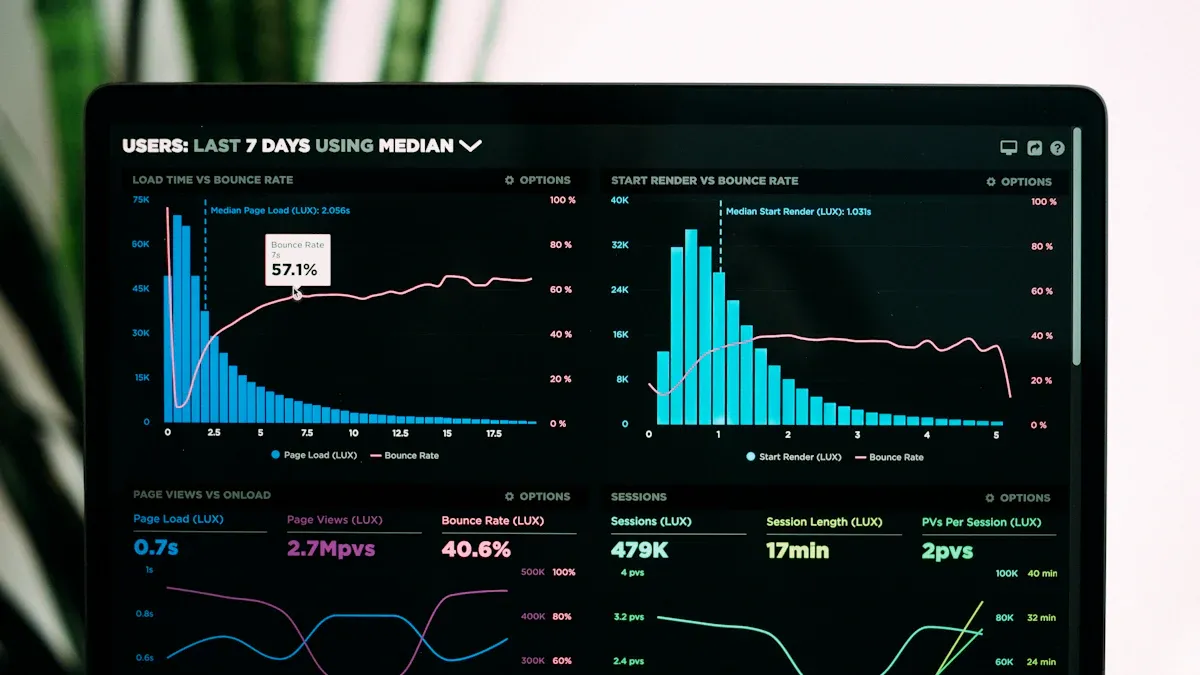
Set Objectives
You should start with clear goals before testing. Decide what you want your headlines to do. Do you want more clicks or more people to stay longer? Maybe you want more people to share your posts. Setting the right goals helps you know if you are doing well. It also helps you plan your tests.
Make sure your goals match your business needs.
Pick important things to measure, like:
Conversion rates
Time spent on page
Social sharing
Subscription sign-ups
Test one thing at a time. This shows what really works.
Split your audience into groups. Try different headlines for each group.
Use real-time data to see trends and change your plan fast.
Tip: Try to get better over time. Look at old tests and use what you learn to keep growing.
Generate Variations
After you set your goals, make headline choices. AI tools help you do this quickly and easily. You can make many headline options in just seconds. The AI looks at old posts, what is popular now, and even feelings to suggest headlines for your readers.
Use AI to make lots of headline choices at once.
Try different styles, like questions or emotional words.
Make headlines special for each group of readers.
Check the AI’s ideas and pick your favorites to test.
News Outlet | Performance Improvement | Metrics Tracked | Testing Methods | Key Insights |
|---|---|---|---|---|
BuzzFeed | Click-through rates, time on page, social media engagement | A/B testing, split testing | AI helps test many headlines fast, making posts better for SEO and social media, which brings more engagement | |
RebelMouse | 15% more social media engagement | Social media engagement metrics | A/B testing | AI-made headlines work better by using SEO and social media tools |
Note: AI can find hidden clues, like which words or styles get more clicks.
Run Tests
Now you can test your headlines. AI-Driven A/B Testing lets you try many headlines at the same time. The system shows different headlines to different people and collects data right away. You do not have to wait a long time for answers.
Use AI to test many headlines with your audience.
Watch how each headline does as the test goes on. The AI will change which headlines show up based on early results.
Try testing more than one thing at once to see how they work together.
Predictive modeling can help you guess which headlines will do best before you start.
AI-powered tools like VWO and Kameleoon give you smart reports and real-time changes. Companies using these tools have seen conversion rates go up by 15-20%. Netflix and Amazon use AI to make headline tests fit each person, which means more people click and sign up.
Tip: AI helps you test more and saves time, so you can spend more time making good content.
Analyze Results
When your tests are done, look at the data. AI tools make this step simple and correct. They use smart ways to check if your results are real.
Check important numbers like CTR, engagement, and conversions.
Use math tools like significance level (α), statistical power, confidence intervals, and effect size to make sure your results are true.
AI can do these checks and run p-value tests in real time.
Bayesian models and predictive analytics help you see which headlines work best and why.
Look at heat maps and reports to see how people act with your headlines.
Tip: Make sure your results are real and not just luck. This means the changes you see really matter.
AI-Driven A/B Testing gives you answers faster and makes them more trustworthy. You can find the best headlines quickly and use what you learn to make better posts next time. Companies using AI for headline testing see about 25% more clicks and 30% more people taking action.
Best Practices
Data Quality
You need good data for the best results with AI-driven A/B testing. Good data helps the AI learn what works and what does not work. If your data is clean and correct, your headline tests are more trustworthy. You will see real changes in your main numbers.
Metric | Definition/Measurement | Improvement with AI-generated Headlines |
|---|---|---|
Click-through rates (CTRs) | Percentage of users clicking the headline | Average increase of 25% compared to baseline |
Time on page | Average duration users spend on the article | Average increase of 30% compared to baseline |
Social shares | Number of times the article is shared on social media | Average increase of 20% compared to baseline |
Engagement rates | Includes likes, comments, and shares on social platforms | Up to 50% more engagement than baseline |
SEO Optimization | Improvement in search engine ranking and visibility | 25% increase reported in case studies |
You can see these changes in the chart below:
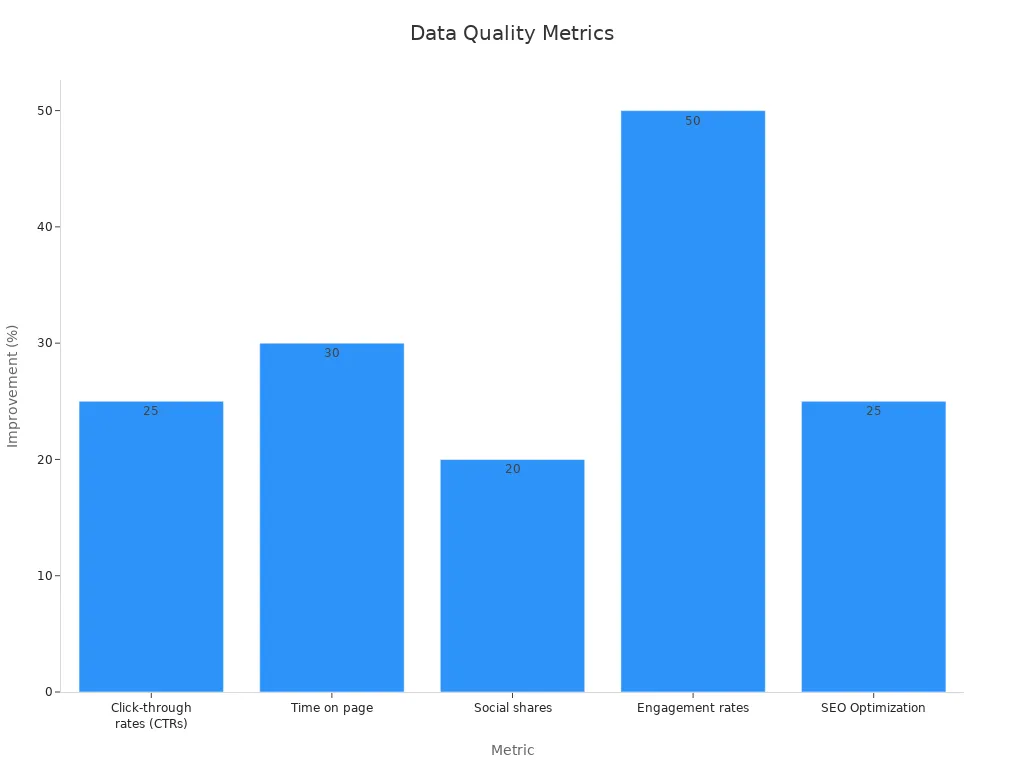
Tip: Always look for mistakes or missing data before you start your tests.
Compliance
You have to follow privacy laws and platform rules when using AI for headline testing. Keep your users’ data safe and respect their privacy. Make sure your AI tools follow rules like GDPR or CCPA. This helps people trust your brand and keeps your company safe.
Only use data you are allowed to use.
Hide personal details when you can.
Check your AI tool’s privacy settings often.
Note: Following the rules keeps you out of legal trouble and helps people trust you.
Overcoming Challenges
You might have problems like not enough time, too few test choices, or human bias. AI-driven tools can help fix these problems by doing data checks and making changes right away. Many companies do well by following best practices and using the right tools.
A SaaS company saved 25% time and made customers happier with AI-powered A/B testing.
Fidelity Investments got 25% better leads and 12% more conversions by using AI to make landing pages personal.
E-commerce brands like SuperAGI raised conversion rates by 35% and average order value by 25% with AI-driven suggestions.
Multi-armed bandit algorithms let you test more choices fast and send more people to the best headlines.
Companies like Amazon and Netflix use teams from different areas and watch results to keep getting better.
Tip: Build a team that likes to test and learn. Stay flexible so you can handle new problems.
Workflow Integration
Tool Selection
You need good tools to make your work easier. Many companies use AI tools to test headlines and get better results. This is a big trend now.
83% of companies use AI to make content better.
Machine learning models help find headlines that get more clicks.
BBC News got more people to stay and interact with AI headline changes.
Amazon Prime Video and Google use AI for subtitles and to guess what content will be popular.
Experts say using AI tools helps you get more clicks, visitors, and money.
Tools like ChatGPT, Claude, and Google Analytics help you make, test, and check headlines.
These tools can run A/B tests and keep making things better. They use numbers like click-through rates and conversions to help you decide what works.
Audience Segmentation
You can reach more people by splitting your audience into groups. AI-Driven A/B Testing lets you pick groups by what they like and do. This helps you get better results in many ways. The table below shows how breaking up your audience helps:
Metric Type | Specific Metric | Evidence of Improvement |
|---|---|---|
Conversion Metrics | Retargeting Conversion Rate | 35% increase among segmented groups |
Customer Feedback | Messaging Relevance (Zigpoll) | 40% improvement confirmed via surveys |
ROI Metrics | Marketing ROI | 25% increase |
Engagement Metrics | Click-Through Rate (CTR) | 20% uplift within 3 months post AI segmentation |
Engagement Metrics | Session Duration | Improved (implied by engagement uplift) |
Engagement Metrics | Bounce Rates | Reduced (implied by engagement uplift) |
Conversion Metrics | Conversion Rate (CVR) | Increased (general improvement noted) |
Revenue Metrics | Average Order Value (AOV) | Increased (general improvement noted) |
Revenue Metrics | Return on Ad Spend (ROAS) | Increased (general improvement noted) |
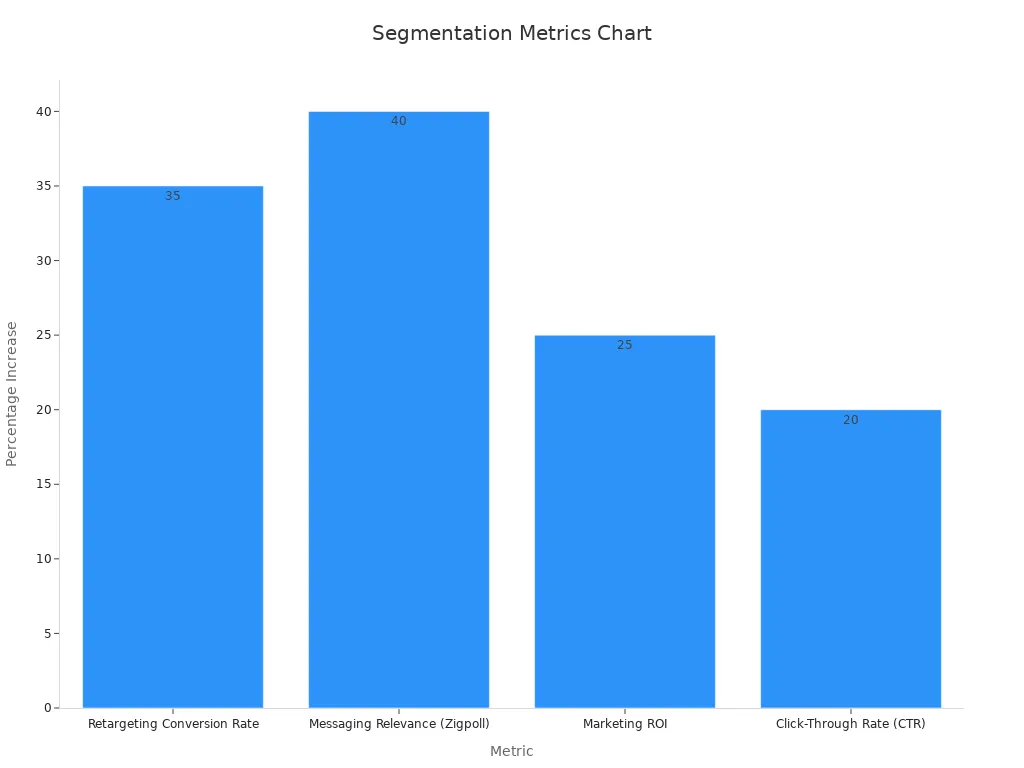
You can use these facts to send the best message to each group. This means more people will click and you will get better results.
Continuous Optimization
You should always try to make your results better. AI tools look at lots of data very fast, so you get answers quickly. For example, Kameleoon’s predictive analytics can guess what visitors will do and help you change things right away. This lets you make changes that get more clicks and sign-ups fast.
Airbnb got 6% more bookings after making 20 good changes out of 250 A/B test ideas. This shows that always improving with AI can help you get real results.
Tip: Keep testing and changing your headlines. Even small changes can make a big difference over time.
You can get better results on social media with AI-Driven A/B Testing. This method helps you learn faster and pick better headlines. You will see your numbers go up. First, choose a good AI tool and run your first test. Look at what happens and keep making your headlines better. Keep working on your headlines to stay ahead as things change online.
FAQ
What is AI-driven A/B testing for social headlines?
AI-driven A/B testing uses artificial intelligence to test different headlines. You let the AI show each headline to your audience. The AI tracks which headline gets more clicks or engagement. You get fast results and clear data.
How do AI tools choose the best headline?
AI tools look at real-time data. They see which headlines get more clicks, shares, or comments. The AI then shows the top-performing headline to more people. You get the best results without guessing.
Do I need coding skills to use AI-driven A/B testing?
Most AI headline testing tools do not require coding. You can use simple dashboards and drag-and-drop features. You set your goals, pick your headlines, and let the AI handle the rest.
Can AI-driven A/B testing improve my social media engagement?
Yes, you can see higher click-through rates and more shares.
AI helps you find headlines that connect with your audience.
Many companies report up to 30% more engagement after using AI-driven tests.
Is my audience’s data safe with AI tools?
You must choose tools that follow privacy laws like GDPR or CCPA. Good AI tools protect user data and keep it private. Always check the privacy settings and policies before you start.
See Also
Effective Social Media Techniques To Boost Blog Visitors
Boost Blog Traffic By Enhancing Email List Interaction
Customizing Blog Posts To Suit Startup Audience Preferences

